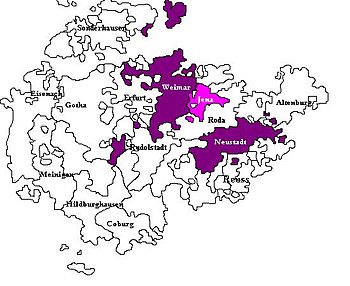Saxe-Weimar facts for kids
Quick facts for kids
Duchy of Saxe-Weimar
Herzogtum Sachsen-Weimar
|
|||||||||
|---|---|---|---|---|---|---|---|---|---|
| 1572–1809 | |||||||||

|
|||||||||
| Status | State of the Holy Roman Empire, then State of the Confederation of the Rhine |
||||||||
| Capital | Weimar | ||||||||
| Government | Feudal monarchy | ||||||||
| Historical era | Early modern period | ||||||||
|
• Division of Erfurt
|
1572 | ||||||||
| 1602 |
|||||||||
| 1640 |
|||||||||
| 1672 |
|||||||||
| 1741 | |||||||||
| 1809 |
|||||||||
|
|||||||||
| Today part of | |||||||||
Saxe-Weimar (German: Sachsen-Weimar) was a small country, called a duchy, located in a region of Germany known as Thuringia. Its main town and capital city was Weimar.
Contents
History of Saxe-Weimar
Saxe-Weimar and Saxe-Gotha were two of the original Ernestine duchies. These duchies were parts of a larger family land that was often divided among sons. Because of this, the size of Saxe-Weimar gradually became smaller over time.
Important Leaders and Cultural Growth
In 1741, Duke Ernest Augustus I of Saxe-Weimar also became the ruler of the Duchy of Saxe-Eisenach. When he died in 1748, his son Ernest Augustus II took over. However, Ernest Augustus II died young in 1758. His wife, Anna Amalia, became the regent for their young son, Charles Augustus. A regent is someone who rules a country when the official ruler is too young or unable to.
Anna Amalia and Charles Augustus were very smart. They loved literature and art. They invited many of Germany's top thinkers to their court in Weimar. These famous people included Goethe, Schiller, and Herder. Because of them, Weimar became a very important center for culture and learning.
Saxe-Weimar and the Napoleonic Wars
Charles Augustus decided to join Prussia during the Napoleonic Wars. These were a series of major conflicts led by Napoleon Bonaparte of France. After France won the Battle of Jena in 1806, Saxe-Weimar was forced to join the Confederation of the Rhine. This was a group of German states that were allied with Napoleon.
In 1809, Saxe-Weimar and Saxe-Eisenach officially became one country. Even though they had the same duke since 1741, they were still considered separate duchies. They merged to form the Duchy of Saxe-Weimar-Eisenach.
Dukes of Saxe-Weimar
Here is a list of the dukes who ruled Saxe-Weimar:
- Johann Wilhelm (1554 – 1573)
- Frederick Wilhelm I (1573 – 1602), son of Johann Wilhelm
- Johann (1602 – 1605), son of Johann Wilhelm
- Johann Ernst I (1605 – 1620), son of Johann
- Wilhelm (1620 – 1662), son of Johann
- Johann Ernst II (1662 – 1683), son of Wilhelm
- Wilhelm Ernst (1683 – 1728), son of Johann Ernst II
- Johann Ernst III (1683 – 1707), son of Johann Ernst II
- Ernst August I (1707 – 1748), son of Johann Ernst III
- Ernst August II (1748 – 1758), son of Ernst August I
- Karl August (1758 – 1809), son of Ernst August II
After 1809, Saxe-Weimar merged with Saxe-Eisenach to create Saxe-Weimar-Eisenach.
Related pages
Images for kids
See also
 In Spanish: Ducado de Sajonia-Weimar para niños
In Spanish: Ducado de Sajonia-Weimar para niños





